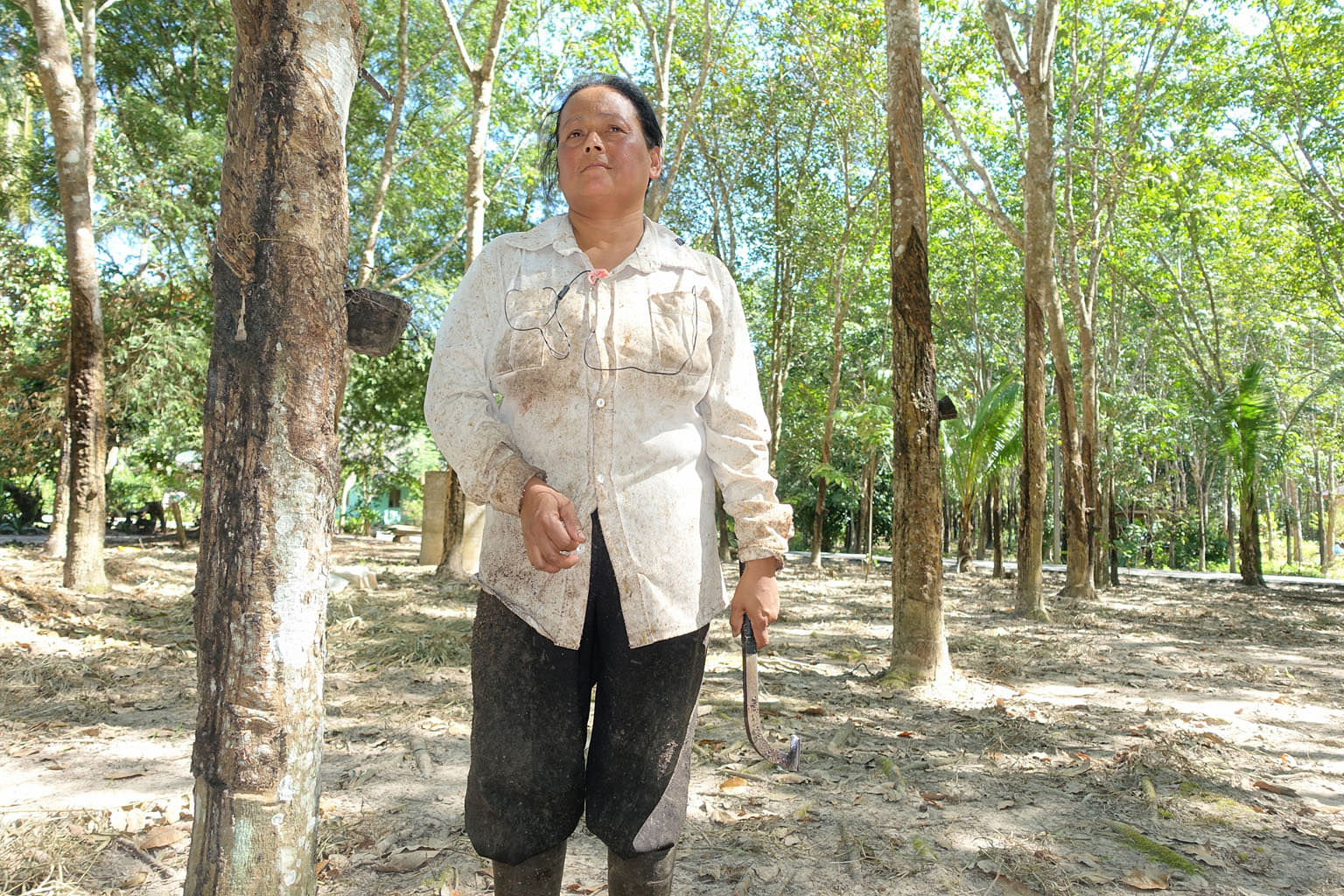SURAT THANI • In the sea of rubber trees stands what locals will call a "farmer's dream home". The pitched roof structure rests on pillars of solid tree trunks, its gently curved staircase inviting visitors up a verandah to catch the rural southern Thailand breeze.
But the house has no walls.In fact, there are some parts with no floorboards, as its owners Somchai and Wandee Choosri struggle to find the money to complete a house they have been building for the past 10 years.
Sliding rubber prices have left the farmers 500,000 baht (S$20,000) in debt. They live in a shack next to their skeletal dream home. And they wonder if they should even let their daughter complete her university studies. "I want her to quit," says Ms Wandee, 50. "But she doesn't want to."
Rubber prices hit a seven-year low earlier this month, as demand from China - which bought39 per cent of the world's natural rubber last year - fell amid a slowing economy.
In some instances, the prices have even dropped below the cost of production, driving small-scale farmers, as well as tappers, into deep financial anxiety.
The rubber trade is inherently cyclical. Each sapling needs about six to seven years to mature, before its bark can be slowly scraped off to produce a creamy white sap that factories transform into tyres, mattresses and fan belts.

In 2011, farmers were able to sell their raw rubber sheets to factories for as much as 180 baht per kg, attracting a rush of new players to the scene. Myanmar, Laos and Cambodia expanded their rubber planting area by 45 per cent between 2010 and last year, according to Dr Lekshmi Nair, a senior economist at the Singapore-based International Rubber Study Group.
The saplings planted during the 2008 boom are now maturing during the glut. Global production of natural rubber hovered around 12 billion tonnes last year, nearly double that of 2000.
This expansion has been controversial. Where plantations popped up, surrounding forests vanished, threatening the well-being of existing communities.
COST OF EXPANSION
In a 2014 report, environmental watchdog Global Witness noted how land concessions granted by the Myanmar government in so-called "wastelands" were in fact a major source of food and livelihood for local farmers.
In Cambodia and Laos, where large-scale rubber plantations have made inroads, "investors appear to have deliberately targeted protected areas, with over 70 per cent of the concessions given out in 2012… situated inside national parks, wildlife sanctuaries and protected forests", it said. Timber from protected species like rosewood - which has a ready market in China - is harvested through such clearance, and trees have even been felled beyond concession boundaries.

Disenchantment over these land grabs has erupted in protests and helped batter the ruling Cambodian People's Party's showing in the 2013 elections.
THE POLITICS OF RUBBER
Over in Thailand, the world's largest producer of rubber, the industry is similarly intertwined with politics. Rubber barons as well as small-scale farmers concentrated in the Democrat Party-dominated south have long wielded electoral clout to extract subsidies from successive governments on both sides of the political divide.

The government run by then Prime Minister Yingluck Shinawatra spent 22 billion baht over seven months from October 2012 buying rubber from farmers. But that could not do much to stop the price from sliding below 80 baht per kg by September 2013. In response, the southern-based farmers set up road blockades to demand more aid.
These same disgruntled farmers later became foot soldiers in the seven-month-long protests led by former Democrat deputy leader Suthep Thaugsuban, which culminated in a coup in May 2014.
Despite starting out adamant against agricultural subsidies, the present military government has also bowed to rubber farmers' threat of protests by buying rubber at 45 baht per kg - about 20 per cent above the market price this week.
In an interview with The Straits Times earlier this month, Agriculture and Cooperatives Minister Chatchai Sarikalya said Thailand was trying to collaborate with Malaysia and Indonesia - two major rubber producers - to maintain a sustainable price for their farmers.
Industry veterans say the chances of success are dim, given how previous attempts had failed.
There are smaller-scale efforts to give farmers a better deal. While some rubber cooperatives are trying to streamline operations to cut production costs, a fledgling electronic rubber spot market called RubberConnex provides real-time auctions via the Internet to connect buyers directly with farmers.
Most experts do not expect rubber prices to ever reach the heights seen four years ago. Depressing prices further is the turmoil in China's tyre sector, a major consumer of global rubber, says Mr David Shaw, the chief executive of Britain-based Tire Industry Research.
The United States' Commerce Department, accusing China of dumping tyres and subsidising tyre makers, slapped import duties amounting to over 100 per cent on Chinese tyre makers last year. That same year, the Chinese government also reduced the proportion of natural rubber allowed in the formula for compound rubber.
All this means there is little light at the end of the tunnel for the Choosris, who have been working as rubber tappers for the past eight years, and accumulating debts while waiting for their own 3.2 ha plantation to mature.
"We thought once we could tap our own rubber trees,we could pay everything back," says the sullen Mr Somchai."Now everything is broken."
This despondence is apparent throughout the southern Surat Thani province, where the Choosris have their plantation and which has the biggest land area covered in rubber trees.
Seventy per cent of the people there are linked in some way to the rubber industry, estimates Mr Damrong Thaugsuban, the deputy chief executive of the province's administrative organisation.
Many there still think the government can be more generous.
"The problem is very easy to solve. It's like one strand of hair covering your view of the whole mountain," says Mr Damrong who, like Mr Suthep, belongs to a clan that retains wide influence in Surat Thani.
Current government rules for the use of natural rubber in road construction specify a 5 per cent rubber content, he noted. That means 2.5 tonnes of rubber is used for a 1km-long, 8m-wide road.
"If the government is really sincere about supporting agriculture, why not make it 30 per cent?" he asks.
He admits, however, that farmers are partly responsible for their plight. When prices of rubber were high, they became "careless" and cut down all their palm trees to grow rubber. Many owners of small plantations also unnecessarily raise costs by hiring tappers instead of tapping the rubber tress themselves. "Southern people are too used to the good life," he laments.
OLD HABITS DIE HARD
Then, there is the issue of familiarity. Rubber, first introduced to Thailand in 1901,has worked its way into the fabric of the south and many cannot imagine life without it.
"It's our culture," says Mr Kittisak Viroj, the chairman of Surat Thani's Rubber and Oil Palm Farmers Association. "If you don't plant rubber, if you don't understand rubber, you are not southern."
Compared to cultivating rice or fruit, planting rubber is relatively easy, farmers say. Once the trees are mature, they do not need to be watered regularly or tended to closely. Its owner, working in the cool of night or wee hours of the morning, need only take a few seconds to tap the latex from each tree.
This means people like Ms Montha Pansang, 48, whose 10,000 baht monthly income is just a fraction of what she made three years ago, are more inclined to try to stick it out rather than look for alternative sources of income, despite government offers of soft loans for farmers to switch to other crops or breed livestock.
The tanned, slight mother of two is nearly 600,000 baht in debt due to loans she took for her farm, house and pick-up truck. Last year, her daughter was almost kicked out of her vocational school because Ms Montha could not afford to buy her a set of uniforms. Her response to this state of affairs is to tap even more trees for other farmers, working from midnight to 11am every day.
"Normally, I tap 1,000 trees a day. Now, even when I cut 2,000, it's not enough," she admits. But changing careers is out of the question."I'm used to this. I don't think I can work for others."
Many say they do not rule out taking to the streets if government help does not lift their fortunes. This is despite the military government's ban on political gatherings, and surveillance of farming group leaders.
The prospect of being jailed for protesting does not faze Ms Wandee. "It will be good," she muses. "At least I get to eat for free."

